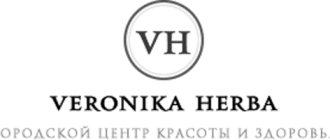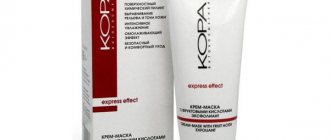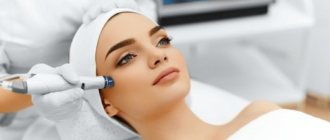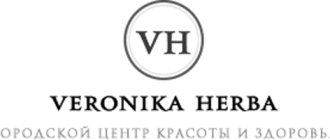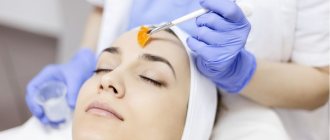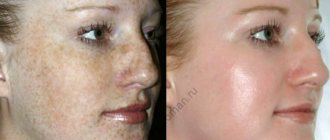From this article you will learn:
- What acids are used for peeling?
- What is a fruit peeling for the face?
- Who is recommended for fruit peeling for face and body?
- How many fruit peeling procedures are needed to achieve results?
- Types of acid-fruit peeling
- Possible side effects when using fruit peeling
- How to carry out fruit peeling in a beauty salon
- Skin care after fruit chemical peeling
- Frequently asked questions about fruit peeling
- Carrying out fruit peeling for the face at home
- Recipes for homemade fruit peeling for the face
- What kind of fruit peeling can you buy at the pharmacy?
- Precautions when carrying out fruit peeling at home
The skin regeneration procedure, which involves fruit peeling, is one of the most popular in beauty salons. The fruit acids used gently exfoliate the upper layer of the epidermis, impart freshness, even out the tone and stimulate renewal. Regular implementation of the procedure allows you to achieve visible results.
Another advantage of fruit peeling is its versatility. It is equally effective for both mature and young skin. If you have not yet discovered the wonders of renewal with fruit peeling, be sure to read our article to the end.
What acids are used for peeling?
- Glycolic
Sugar cane and green grapes are rich in this acid. The substance has a very low molecular weight, which means that it can easily penetrate the dermis and cause a response. This AHA acid is most in demand in cosmetology. It is usually used alone or in combination with other fruit and non-fruit acids.
The action of glycolic acid occurs at the level of the epidermis. The substance activates the production of collagen protein, which affects the structure of the skin tissue. That is why the glycolic variety is called remodeling peeling.
- Dairy
This acid is produced by Lactobacillus bacteria. Lactic acid is found in sour milk, apples, grapes, tomatoes, blueberries and some other berries. In addition, it is included in the natural moisturizing factor (NUF). This acid has a slight exfoliating and moisturizing effect. It is recommended for use on sensitive and dry skin.
- Almond
This acid is obtained from sweet almond grains. It has a mild effect. Mandelic acid can be purchased for professional fruit peeling of the face. In addition, it is included in home cosmetics used for regular care.
- Apple
It is found in large quantities in apples and tomatoes. It is often used to lightly exfoliate epidermal cells.
- Wine (tartar)
This acid is present in grapes, wine, and oranges. The substance exfoliates, whitens and moisturizes.
- Lemon
Found in lemons and other citrus fruits, as well as pineapples. This acid is the heaviest of all fruits. The main quality for which it is valued is its whitening effect (especially in combination with tartaric acid). In addition, citric acid is endowed with antioxidant properties.
- Phytic
Contained in cereals (rice husks, quinoa). Has a mild exfoliating effect.
Over the past decades, interest has sharply increased and the range of acid peels used in cosmetology practice has expanded.
The composition of these peels mainly includes hydroxyacids (HA), known in wide practice as both fruit acids and non-fruit acids. Fruit acids include alpha hydroxy acids, or abbreviated AHA acids (glycolic, lactic, malic, tartaric, citric), beta hydroxy acids BHA (salicylic acid), polyhydroxy acids PHA (gluconic and gluconolactonic), and bionic acids BA ( lactobionic, maltobionic, cellobionic), as well as phytic, succinic, azelaic acids. This interest is associated with the unique properties and capabilities of acid peels in solving aesthetic skin problems.
Characteristics of hydroxy acids
Let's consider the effects of AHA acids on the skin. Fruit acids got their name due to their content in fruits, and the chemical name - alpha hydroxy acids - due to the hydroxyl group located in the alpha position of organic carboxylic acids. In the body, fruit acids take an active part in metabolism, being metabolites of many chemical reactions.
Spectrum of biological activity of AHA acids
The effects of AHA peels are more gentle and depend on the acid pH concentration and molecular weight.
The exfoliating exfoliating effect of AHA acids is associated with their effect on corneocytes and the ability to weaken their cohesion with horny scales in response to increased peeling of the skin and through increased loss of transepidermal water, stimulating the activation of basal cells and thickening of the proliferative layer of the epidermis.
The moisturizing effect of AHA is associated with the removal of the old stratum corneum, which does not have a natural moisturizing factor (NMF) and creates a moisture deficiency in the skin, since the moisturizing factor of only young keratinocytes is not enough to hydrate the entire stratum corneum of keratinocytes.
After the exfoliation of old corneocytes and the release of young NMF horn cells to the surface, the skin hydration indicator significantly increases. In addition, citric and lactic acids are components of NMF, thereby increasing its functional content in the skin.
One of the effects of AHA acids is to enhance the synthesis of glycosaminoglycans, collagen and the intercellular substance of the dermis, which makes the skin smoother, firmer and more elastic. Fruit acids also have antioxidant properties, protecting the skin from the effects of reactive oxygen species, and can lighten the skin and reduce hyperpigmentation.
Thus, under the influence of acids in the epidermis, the proliferative keratinocyte layer is built up, the stratum corneum is leveled and thinned, and the intercellular dermal matrix is strengthened, thereby thickening the dermis.
Alpha hydroxy acid peels contain the following acids:
- Glycolic acid is the smallest and most popular of the AHA acids, its molecular weight is 76.05 g/mol, and therefore easily penetrates the epidermal barrier. Contained in sugar cane, green grapes, sugar beets, it promotes the production of type 1-3 collagen and is the main component of modern AHA peels, both professional and home.
After a thorough study of the effects of glycolic acid on a living culture of human fibroblasts, scientists made the following conclusions: the depth of penetration of glycolic acid in the epidermis depends not only on its concentration and exposure time, but also on pH.
The lower the pH of the drug, the higher the permeability of glycolic acid and the higher its irritating ability. There is a very close relationship between the pH of glycolic acid and its effect on the rate of renewal of epidermal cells and the degree of skin irritation. At a concentration of 70% pH 3, the acid gives a noticeable stimulating effect, but also a noticeably high degree of skin irritation; if the acid solution is neutralized to pH 7, the stimulating effect becomes insignificant, but the skin irritation becomes noticeably less. The use of this substance in a low concentration - about 20-30% and a pH of 2-3 for a long time leads to increased exfoliation of dead cells. At the same time, the complexion is evened out, and the surface of the skin becomes smoother.
Relationship between glycolic acid pH, cell turnover rate and skin irritation
- Lactic acid - with a molecular weight of 90.08 g/mol is a product of biofermentation of sour milk, sauerkraut, blueberries, apples, tomatoes and other products. The exfoliating and moisturizing ability comes first. But compared to glycolic acid, lactic acid is gentler and can therefore be used on sensitive skin.
Lactic acid has the same properties as all AHA acids. I would like to pay special attention to its moisturizing properties. At the molecular level, it is part of NMF, adjacent to amino acids, urea, pyrrolidone carboxylic acid and other components.
Lactic acid binds and retains moisture, creating a kind of water shell around itself. Moreover, moisture is not only collected, but also correctly redistributed towards the deep, living layers of the skin, which allows you to create the effect of balanced hydration in the epidermis. Another useful property of lactic acid is to enhance the barrier functions of the skin, promoting the production of ceramides, which, together with cholesterol and fatty acids, form a lipid layer, due to which the skin loses less moisture and better resists stress factors and water-saving mechanisms work not only on its surface, but also inside the dermis. The whitening property of lactic acid is based on both its exfoliating ability and the effect of lactic acid on blocking tyrosinase, which is responsible for skin melanogenesis. The antibacterial properties of the acid are based on the acidifying effect, as well as special laction particles, which slow down the development of many microorganisms.
Photo 5. Therapy for skin photoaging, woman, 62 years old: a - right hand after 6 months of using placebo lotion; b — left hand after 6 months of using lotion with 25% lactic acid (the skin is denser and more elastic, the number of age spots has decreased)
- Malic acid (malonic, hydroxysuccinic acid) - molecular weight 134.1 g/mol, isolated from the pulp of unripe apples and tomatoes, grapes, gooseberries, rhubarb, rowan fruits, barberries, raspberries. In general, apple peeling is a special case of fruit peeling, in which the concentration of malic acid among other fruit acids is 10-15%.
At the same time, malic acid peeling is not only characterized by moderate results in smoothing out deep wrinkles and scars, but also effectively helps in polishing and evening out the complexion and increasing firmness and elasticity, as it actively stimulates cellular metabolism.
- Tartaric acid (tartaric acid) , molecular weight 150.087 g/mol. The main sources of tartaric acid include dried wine yeast and tartar, which forms on the walls of the vessel during wine fermentation. Tartaric acid is a strong antioxidant and biostimulant. Being part of any cosmetic product, it has an exfoliating and moisturizing effect.
The result of acne treatment with a combined course of booster peels: a - before treatment; b - after. When carrying out peeling after applying glycolic acid to the skin, a composition containing 20% mandelic and 10% citric acids was additionally used
- Citric acid is found in citrus fruits (lemon, lime, grapefruit, orange). It has the highest molecular weight of the AHA acids described above - 192.12 g/mol. It has a whitening effect on the skin, which is enhanced in the presence of tartaric acid. Has antioxidant and bactericidal properties.
- Mandelic acid is obtained by hydrolysis from bitter almonds. The large molecular weight of this acid promotes slow diffusion into the epidermis and makes almond peeling very gentle, suitable for patients with various skin types, including sensitive ones. By gently loosening the superficial stratum corneum, this peeling has a delicate exfoliating effect that evens out and brightens skin tone. The lifting effect is due to the production of collagen and elastin, due to this, cellular renewal is activated and shallow wrinkles are smoothed out. Almond peeling can be used in the summer, as the risk of developing hyperpigmentation after the procedure is minimal. Having a structural similarity to macrolide antibiotics, it suppresses the proliferation of pathogenic skin flora and thereby reduces the risk of infection and skin inflammation.
Mandelic acid is capable of binding heavy metal salts, having powerful antioxidant properties. Improves inflamed acne by clearing and removing blockages in the sebaceous gland ducts, thereby reducing and tightening pores and removing black comedones.
- Salicylic acid is a beta-hydroxy acid because its hydroxyl group is bonded to the carbon atom in the β position (next to α in the hydrocarbon chain) and is fat soluble. Salicylic peeling has been used in cosmetology for a long time, but has not yet lost its popularity. Possessing high penetrating ability and a keratolytic effect, this beta acid causes active peeling at the mouth of the hair follicle, which prevents the formation of comedones.
Salicylic peeling, depending on the concentration and pH, can be superficial or mid-superficial. Superficial salicylic peeling is used for problematic oily skin and acne. The concentration of salicylic acid in this case is 15-20%, and the pH is from 2 to 3.5.
When using salicylic peeling with higher concentrations and low pH, deeper peeling occurs. By exfoliating the entire stratum corneum and the top of the proliferative keratinocyte layer of the epidermis, salicylic acid not only stimulates the active production of collagen and elastin, but also leads to active stimulation of basal cells and renewal of the epidermis. Therefore, this beta acid is widely used in the fight against aging skin and other signs of aging, such as rough, rough skin. After the procedure, the skin is tightened, smoothed, sagging is eliminated, and the appearance noticeably improves. In addition to the rejuvenating effect, salicylic peeling has a keratolytic effect, which significantly improves the condition of oily skin prone to acne. The lightening effect is associated with a pronounced exfoliating effect, in which horn cells with spent melanin are removed. Salicylic peeling has many advantages, such as easy implementation and controllability of the procedure, the possibility of carrying out the procedure at any age, as it is suitable for patients with a high level of skin photoaging, can be used both on the face and on any part of the body, applicable to all four skin phototypes, minimal number of contraindications. Salicylic acid, which is quite harsh and aggressive in itself, is rarely used in its pure form; to soften it, fruit acids are added to the peeling composition.
- Pyruvic acid is the second lipophilic acid in modern peels. Pyruvic acid (PKP) is α-ketopropionic acid, or pyruvate, an organic keto acid that has the properties of carboxylic acids and ketones, and is also the end product of the glycolytic breakdown of glucose. Pyruvic peeling is obtained from tartaric and lactic acids. It has a sharp, unpleasant odor, but does not cause allergies, since it has a similar composition to skin and is completely recycled in human tissue. PVK is found in all tissues of the body and takes part in many biological processes. Low molecular weight - 88.06 g/mol - combined with lipophilicity gives PVC a high penetrating ability, more than glycolic, but controlled like trichloroacetic acid. When it comes into contact with the skin, PVC is hydrolyzed and converted into lactic acid, which is part of the skin's moisturizing factor and provides good hydration to the skin.
Therefore, PVC is used in the correction of the following aesthetic problems: seborrheic dermatitis, rosacea, hyperpigmentation, photoaging, dermal atony, dark circles under the eyes.
Acids used in later cosmetology practice
- Azelaic acid (nonanedioic acid) is a dibasic saturated carboxylic acid that has all the chemical properties characteristic of carboxylic acids. It is obtained by ozonolysis or oxidation of oleic or linoleic acid. It has pronounced antioxidant properties, models the processes of keratinization in the sebaceous glands with closed comedones and seborrheic dermatitis.
Inhibits the action of 5-α-reductase, reduces sebum production, normalizes the process of sebum formation, thereby preventing the appearance of black comedones. It has an antimicrobial effect on opportunistic skin saprophytes Propionibacterium acnes and Staphyloccocus epidermidis. The whitening effect of azelaic acid is similar to hydroquinone, which is achieved by inhibiting the enzyme tyrosinase, and also inhibits the synthesis of DNA and RNA of melanocytes, slowing down the proliferation of keratinocytes.
Azelaine peeling
Azelaine peeling is a superficial peeling and is used to solve dermatological problems: demodicosis, acne and post-acne, ingrown hairs, hyperpigmentation, rosacea, folliculitis, rosacea, melasma, seborrheic dermatitis, etc.
In addition to azelaic acid, manufacturers often add lactic, citric, glycolic, salicylic and almond acid to this peeling, which, depending on the proportions and concentration, eliminate varying degrees of severity of skin diseases.
The main active component of the peeling preparation in this case is azelaic acid with a concentration of 15-30% and pH 1.8-1.3. Azelaine peeling is easily tolerated, has a mild irritating effect on superficial tissues, and does not require a long recovery period.
- Phytic acid , or myo-inositol hexaphosphoric acid, is found naturally in cereal seeds, legumes, some vegetables, and also in oilseeds. Due to its high molecular weight of 660.04 g/mol, even at a high concentration of 50% and a low pH of 1.2, it does not cause damage to the deep epidermal layers. It has been proven that phytic acid, along with a deep and very gentle cleansing and exfoliating effect, has the ability to inactivate the enzyme tyrosinase, the excessive production of which leads to hyperpigmentation. This determines the high antioxidant, lightening and anti-inflammatory properties of phytic acid, which contribute not only to the effective prevention of the appearance of age spots, but also to the rapid elimination of existing ones. Along with this, phytic acid has a good rejuvenating and lifting effect, narrows enlarged pores, fights keratomas and rosacea.
Phytin peeling
Phytin peeling is superficial. Its implementation does not require neutralization. In addition to phytic acid, peeling compositions often include a high percentage of glycolic or tartaric acid. Experts classify phytin peeling as an all-season peel and recommend using it even during periods of high solar activity.
Polyhydroacid peeling
- Polyhydroacid peel with gluconolactone, or D-gluconic acid δ-lactone, is an ester with a cyclic structure.
Gluconolactone is found naturally in honey, wine, corn, some fruits and tea. Its action is similar to that of α-hydroxy acids, but the properties of polyhydroxy acids have significant differences. Being an AHA acid with five hydroxyl groups in the molecule, it has more pronounced moisturizing properties. The absence of a carboxyl group in the ether form of the molecule helps eliminate the irritating effect on tissue. Thanks to its high molecular weight, this peel slowly penetrates the epidermis, thereby not causing a pinching effect on the skin, and is therefore recommended for the most sensitive skin. Gluconolactone is a natural antioxidant, comparable to vitamins A and E, capable of blocking processes that activate the synthesis of interleukin-1 to suppress inflammatory reactions in the skin. Gluconolactone modulates skin pH, which helps restore the acid mantle of the epidermal barrier also by activating lipid synthesis in keratinocytes. An important mechanism promoting hydration is the ability of gluconolactone to transport water molecules, thereby stimulating the lipid synthesizing activity of keratinocytes through a decrease in the concentration of calcium ions. The brightening property of gluconolactone is associated with the ability to form chelate complexes with metals and remove free radicals. The latter may be iron, contained in skin cells and causing natural oxidation processes. Excess iron, combined with exposure to ultraviolet radiation, causes more pronounced pigmentation - a typical sign of bio- and photoaging.
Gluconolactone initiates both the synthesis of the dermal matrix of the skin, elastin and collagen, and the production of the ground substance of the dermis
- hyaluronic acid. Its keratolytic effect leads to an even skin tone.
- Bionic acids belong to another group of polyhydroxy acids. The leader in cosmetology practice is Lactobionic acid, or 4-O-β-galactopyranosyl-D-gluconic acid. It consists of gluconic acid and galactose connected by an ester bond, formed due to the oxidation of milk sugar.
The stabilizing properties of lactobionic acid are associated with the ability to synthesize chelate compounds with metals of variable valence, including iron.
Being, like gluconolactone, a substance with a large molecular weight, it slowly penetrates the skin and does not cause an irritating effect, does not provoke excessive peeling, hyperemia and itching of the face. Galactose, which is part of lactobionic acid, promotes rapid recovery and rapid regeneration of damaged skin structures. Therefore, lactobione peeling can be used for active recovery after traumatic procedures such as laser resurfacing, plastic surgery, deep peelings, microdermabrasion.
And the property of this acid to inhibit matrix metalloproteases, when activated, destroys the main components of the dermal matrix, helps combat photoaging. After application to the surface of the skin, lactobionic acid creates an aqueous film, which for a long time prevents the skin from drying out and the development of an unpleasant feeling of itching and tightness. The gentle exfoliating effect allows you to use this peeling during the work week. And powerful photoprotective properties allow you to use lactobionic acid along with mandelic acid in the summer, without fear of the appearance of age spots.
- Succinic, or butadionic acid (mineral organic resin) is another amazing substance that is extracted from certain plants and amber. It is also synthesized in the human body and does not have the aggressive properties of other chemical compounds. Butadionic acid strengthens capillary walls, improving microcirculation. It improves cellular respiration processes and is capable of restoring and rejuvenating aging tissues, has a mild effect and is used in the treatment of rosacea, hyperpigmentation, hyperkeratosis, and dermal atony.
Conclusion
Typically, professional peelings include not one acid, but several, a so-called cocktail, which allows you to potentiate the positive effect and deactivate the negative effect on the skin. And we should not forget that the deeper the peeling affects, the more pronounced the effect on the skin it has, but the risk of complications such as pigmentation, herpes, inflammatory processes, and the formation of secondary dryness due to the appearance of a keratohyalin film increases.
Therefore, in order to achieve maximum effect, it is equally important to pay great attention to the further rehabilitation period at home, using creams that can quickly restore the epidermal barrier of the skin, and these creams should contain a minimum content of synthetic chemical components.
Natalya Skurikhina, biochemist, dermatocosmetologist, developer of peelings and cosmeceuticals SuNViPeel, cosmetic line Vinas, technologist of natural cosmetics Organic AllSkin, member of the association of doctors KALDAT (South Korea), head of the “School of Peels”, Almaty
What is a fruit peeling for the face?
Not long ago it was noticed that fruit acids have beneficial properties. They began to be used in various branches of medicine. But only after a considerable period of time did fruit acids begin to be used in cosmetology.
Another abbreviated name for these elements – AHA acids – is derived from the full “alphahydroxy acid”. These substances help:
- make facial skin lighter;
- remove excess pigmentation;
- even out complexion.
If you use fruit acids, you can eliminate many skin problems. Scientists have proven that AHA acids can prevent the appearance of natural signs of skin aging. Such signs primarily include wrinkles and loss of tone.
Who is recommended for fruit peeling for face and body?
Cosmetologists advise doing fruit peeling for people who have the following problems:
- the skin is peeling;
- there is an oily sheen on the skin;
- the presence of acne and acne was noted;
- the skin has an uneven color;
- the skin has become loose;
- the appearance of small facial wrinkles was noted;
- the contour of the face has become unclear;
- skin looks dull;
- Scars and grooves often form;
- there are signs of hyperkeratosis and too rough skin;
- pigment spots are visible on the skin.
After just a few procedures, the result will become noticeable. And all thanks to the fact that fruit acids provide an excellent anti-inflammatory effect. The active ingredients enter under the upper layer of the dermis into the skin, destroying germs and infections that cause rashes to appear on the face.
Fruit peeling can be performed by women of any age with different skin types.
Teenagers are recommended to use this procedure to get rid of acne and acne scars.
Recommended articles on the topic:
- Ultrasonic facial peeling is a pleasant and beneficial procedure for your skin
- Redermalization of the skin: all the pros and cons
- Almond peeling for the face: features of the procedure
Cosmetologists advise older patients to do fruit peeling in order to delay the appearance of signs of aging, as well as to eliminate excessive pigmentation on the skin.
It is important to know: if the skin is oily, then the cleansing procedure with fruit acids is performed at least 2 times a week. For normal and dry skin, once for 7 days is enough.
Cosmetologists do not recommend performing fruit peeling in the summer, since the acid, the effect of which is enhanced by sunlight, literally burns the skin. As a result, the effect can be exactly the opposite - the aging of the skin accelerates, freckles and age spots begin to appear in large numbers.
Almond peeling
✹❀❄
Superficial almond peeling is in constant demand among clients of beauty salons. This is due to its many benefits. Almond peeling has a moisturizing, stimulating and antioxidant effect and is ideal for combating the initial signs of skin aging. Professional almond peeling Medic Control Peel has an additional antimicrobial effect, therefore it is often used to treat problem skin with signs of acne. The mandelic acid molecule is quite large, which determines the gentle effect of the peeling composition on the skin and almost completely eliminates the risk of developing post-peeling hyperpigmentation. Delicate almond peeling is recommended for year-round use for patients with skin of any type. Including dark skin by stimulating the regeneration of young cells of aesthetic medicine by a cosmetologist.
How many fruit peeling procedures are needed to achieve results?
As a rule, the fruit peeling procedure (pictured above) is prescribed by a doctor after examining the patient’s complaints about the condition of the facial skin.
In some cases, you may need only one session rather than a course, which is an undoubted advantage of peeling using fruit acid.
Below is a table with a classification of all possible skin problems and the number of sessions that need to be performed (depending on the client’s age).
The number of manipulations may vary depending on the patient’s age and the individual characteristics of his skin.
- Types of acid-fruit peeling
The depth of effect of fruit peeling is affected by the acid concentration and pH of the peeling solution. Moreover, the lower the pH (the more acidic the solution), the more intense the effect of the acid.
- Superficial fruit peeling
For superficial fruit peeling, glycolic, lactic, malic, tartaric or citric acid is used. This procedure can be done at home. As a rule, superficial fruit peeling is useful for the following problems:
- aging skin;
- some forms of acne;
- excessive pigmentation.
The procedure helps smooth the skin and accelerate regeneration processes in epidermal cells. As a result of this peeling, the skin acquires a healthy appearance.
Superficial fruit peeling cannot be done if you have:
- allergy;
- inflammatory processes;
- damage to the epidermis.
- Medium fruit peeling
It must be kept in mind that this type of peeling must be performed by an experienced cosmetologist. The result obtained after this procedure is more noticeable compared to the effect of superficial peeling.
Medium fruit peeling is effective for:
- natural aging of the skin;
- presence of scars;
- hyperkeratosis;
- excessive pigmentation.
Cosmetologists advise regularly using this type of peeling after 35 years. It is not recommended to do it in summer. Fruit peeling can be performed not only on the face, but also in the décolleté, neck, and thighs.
The procedure is contraindicated for:
- herpes;
- hypertension;
- epilepsy;
- hyperpigmentation.
Redness after a medium fruit peel can last for a week.
- Deep fruit peeling
This type of peeling is carried out only in a specialized salon, because this procedure is dermatosurgical.
It is usually used if there are problems:
- hyperkeratosis;
- deep wrinkles or noticeable scars;
- pigmentation.
Deep fruit peeling is contraindicated for:
- pregnancy;
- herpes;
- diabetes mellitus;
- the presence of damage and inflammatory processes on the skin;
- diseases of internal organs.
Important! This procedure can only be performed with the permission of a doctor. The skin will recover over several months.
Possible side effects when using fruit peeling
Most clients tolerate the procedure without problems. Almost no one has any painful reactions from the body (except for a slight burning sensation of the skin).
But it should still be noted that in some cases side effects may occur. In addition, judging by customer reviews, there are some among them who have experienced negative consequences.
The main side effects are an allergic skin reaction to any element of the solution or a minor burn. These phenomena are infrequent and in most cases occur due to the incorrect dosage of the drug, its inconsistency with the skin type, and the unprofessionalism of the cosmetologist.
Negative consequences can be avoided if you strictly follow the specialist’s recommendations and properly care for your skin during the rehabilitation period.
How to carry out fruit peeling in a beauty salon
Fruit peeling using professional preparations with a high concentration of acid is carried out exclusively in specialized salons. The more active component in the peeling, the more effective the procedure. Only a professional will select the required amount of fruit acid, focusing on your skin type and the specifics of your problem.
We recommend
Laser aesthetic cosmetology: perfect technology for an ideal appearance Read more
In addition, the entire process must be carried out under strict control and in compliance with a clear sequence. If you do not adhere to the necessary requirements, undesirable consequences will arise that will affect the client’s health.
- Before the procedure, the cosmetologist prepares the skin: using gel or foam, removes makeup and thoroughly cleanses the pores of impurities.
- The face is covered with the main peeling composition (in the form of a gel), which depends on the client’s skin type. The substance is left on the face for 10 minutes, after which it is washed off with clean water.
- The last step is to treat the skin with a toner and apply an acid neutralizer. Additionally, you can apply a soothing mask to your face.
Important! Immediately after peeling, do not expose the skin to direct sunlight.
Before going outside after the fruit peeling procedure, you need to apply a cream containing UV filters to prevent sunburn.
BHA acids
BHA acids in cosmetics (beta-hydroxy acids) are essentially just salicylic acid.
BHA acids are fat-soluble, which means they easily penetrate pores and clean them, dissolve blackheads, have an anti-inflammatory effect, help prevent pore clogging, treat existing pimples and prevent new ones from appearing.
Salicylic acid is most often recommended for people with oily, acne-prone skin.
BHA acids work at a concentration of 1-2% and pH up to 4%.
Cosmetics with salicylic acid:
- Paula's Choice Clear Extra Strength Anti-Redness Exfoliating Solution is an exfoliating facial toner with 2% salicylic acid.
- Paula's Choice Skin Perfecting 2% BHA Liquid Exfoliant - and another similar toner (in terms of effect on the skin they are approximately identical) with 2% salicylic acid
- Omorovicza Midnight Radiance Mask is a night exfoliating and moisturizing facial mask with salicylic acid, copper gluconate and hyaluronic acid.
- Cosrx, Natural BHA Skin Returning A-Sol, 100 ml - Serum with salicylic acid.
- Benton, Aloe BHA Skin Toner, For All Skin Types, 200 ml - Toner with salicylic acid
- Cosrx, BHA Blackhead Power Liquid, 100 ml - Toner with 4% salicylic acid at an affordable price
Skin care after fruit chemical peeling
Skin that has undergone a peeling procedure needs careful care. What is necessary?
- Apply products with UV filters (creams) to your face.
- Do not go to the bathhouse or sauna for 1 month.
- Do not use scrubs or clean your face mechanically.
- Do not sunbathe in a solarium or under the sun.
- Do not use film masks for 2 months.
- Do not use alcohol-containing solutions for 1 month.
In the first 7 days, avoid junk food.
Disadvantages of this procedure
Since exposure to acids on the skin is an aggressive process, this technique has disadvantages:
- a large list of contraindications;
- painful sensations due to chemical burns of the skin;
- long rehabilitation period - for superficial and medium penetration of acids is 10 - 14 days, for deep penetration - up to 2 months;
- possible appearance of hyper- or hypopigmentation - dark or light areas on the skin;
- Usually one procedure is not enough - treatment and rejuvenation must be carried out over a course;
- acids can cause allergies, even if there were no complaints of a reaction before the procedure.
After the session, you should not sunbathe for a long time under the sun or in a solarium, since ultraviolet radiation can cause complications. Therefore, acid exfoliation is not recommended in the summer; it is better in the cold season.
Frequently asked questions about fruit peeling
What is the price of fruit peeling?
The price of a session is affected by the brand and manufacturer of the drug, the type of acid and the concentration of the substance. In addition, the cost of peeling depends on the class of the salon and the level of professionalism of the cosmetologist.
The course includes from 6 to 10 procedures, between which it is necessary to take a break of 7–10 days. The average price for one session is no more than 1,500 rubles, provided the procedure is performed in a regular cosmetology clinic. In large centers that use modern drugs and equipment, the price tag increases by several thousand rubles.
Is it possible to do fruit peeling at home?
You can also perform fruit peeling at home. The main thing when carrying out the procedure is to strictly adhere to the manufacturer’s recommendations.
Is it possible to get rid of pronounced dark circles under the eyes with the help of professional fruit peeling?
You won't be able to get rid of this problem with peeling. This task can be achieved by contouring, mesotherapy, blepharoplasty or eyelid correction.
Acne left scars on the skin. Will professional fruit facial peeling help cope with them?
Even the best fruit peeling, unfortunately, will not be able to remove severe acne scars. TCA peeling and laser resurfacing solve the problem more effectively.
Does fruit peeling eliminate wrinkles in the eye area?
Fruit peeling, used for these areas of the face, helps improve the regeneration processes of epidermal cells. Moreover, in this case, only superficial peeling is acceptable. However, fruit acid is powerless for problems with wrinkles. Only Botox can cope with them.
Advantages of this procedure
Acid peeling has many advantages:
- effective at any age, provided the correct composition is selected;
- stimulates cell renewal, promotes rejuvenation;
- activates tissue regeneration;
- helps reduce the depth of scars and cicatrices;
- effective in the treatment of acne, acne, comedones;
- restores the structure and oval of the face;
- removes hyperpigmentation, freckles, age spots;
- normalizes a healthy complexion;
- promotes collagen production, thereby increasing skin elasticity and firmness;
- inhibits fading processes;
- reduces the depth of wrinkles, fights sagging;
- reduces pores, normalizes sebum production;
- controls water balance;
- provides full access of oxygen and nutrients to cells;
- stimulates blood circulation and microcirculation;
- restores velvety and smoothness of the skin.
Chemical exfoliation is one of the effective ways to rejuvenate and heal the skin. The technique provides the fastest possible results; it is an excellent alternative to surgical interventions and plastic surgery.
Carrying out fruit peeling for the face at home
Fruit peeling is suitable for home use. Professional cosmetics contain more AHA acids. This concentrated drug eliminates problems more effectively.
Those products that are sold in stores have a lower concentration of active substances than their counterparts in specialized salons.
Interesting fact: by undergoing one to three sessions of fruit peeling in a cosmetology salon, you can eliminate many facial skin problems.
Since specialized cosmetics contain a larger amount of AHA acids, there is a risk of side effects after their use.
Products for home use are less aggressive. However, to eliminate the problem, they must be used regularly. Homemade masks should not contain more than 25% fruit acid. It is recommended to apply the product in the evening, when the skin better perceives beneficial substances.
Safety test
Everyone's sensitivity is different, so before using a new cosmetic product for the first time, be sure to do a test on a small area of skin, for example, in the elbow area. If after a day there is no irritation in this place, then everything will be fine with your face too.
How to understand if everything is happening correctly? This is visible to the naked eye. With proper care, you will shine with health. If you overdo it with active substances, tightness, peeling, and even burning will appear. This is a signal that the tactics are wrong and it’s time to slow down. In the first days, those with particularly sensitive skin may experience slight redness when using a new beauty product. But if it occurs over several days or gets worse, the remedy is not suitable for you.
Remember, if you buy a cosmeceutical “jar,” it may contain AHA acids in noticeable concentrations. Before using them, it is better to consult your cosmetologist. This will protect you from unwanted consequences and help you achieve your goal in a short time.
Do not miss
- Do not miss
Serums, beauty concentrates and other elixirs of youth: how to choose?
Recipes for homemade fruit peeling for the face
If it is not possible to purchase specialized products, you can make a product from available components. But you need to understand that you won’t be able to get the same effect as in the salon. Therefore, you should not hope for significant changes from home peeling.
- Peeling with lemon
To prepare the composition you will need the following ingredients:
- lemon juice;
- olive oil and rosehip oil.
All components must be taken in equal quantities. Pour the mixture into a container, put it on the fire and heat it up a little. Apply the warm mixture to your face. Wait about ten minutes and rinse with clean water.
- Peeling with orange
To prepare the mixture, you need to use:
- crushed orange;
- ground coffee beans;
- flower honey
Take one tablespoon of each component and mix. Apply the product with massaging movements onto the skin of the face. Leave to act for 10 minutes, then rinse well with water.
- Tropical peeling
Includes:
- 1 banana;
- 1 pineapple;
- 1 kiwi.
All fruits must be peeled and then chopped in a blender. Gently apply the resulting mass onto your face. Leave to absorb for 10 minutes. After this time, the mixture is washed off.
- Apricot peeling mask
The fresh apricot fruits contained in the mask will help your skin acquire an even color and get rid of acne.
To prepare the peeling mixture you need:
- 4 things. apricot (it is better to take fleshy fruits);
- 1 tbsp. l. sleeping coffee (grounds);
- 1 tbsp. l. honey
Grind the fruit to a paste. Add coffee grounds to the resulting mixture, and then honey. Mix everything thoroughly. Apply the mask with massaging movements onto cleansed facial skin and leave for 10-12 minutes. Wash off with cold running water. After several procedures, the skin condition will noticeably improve.
- Lemon-banana mask
During the autumn and winter periods, the skin must be cleansed, moisturized and nourished. Your facial skin will improve significantly if you use banana pulp and lemon juice to care for it.
To prepare the mask you will need:
- freshly squeezed lemon juice (1 tbsp);
- 1 tbsp. l. fermented milk product (kefir, fermented baked milk, yogurt);
- cane sugar (1 tbsp);
- ½ banana.
Take a ceramic container and mash a banana in it. Pour lemon juice, fermented milk product into the resulting mass and add cane sugar. Mix all components thoroughly to obtain a homogeneous paste. Apply the mask evenly to the face. Leave for 5-6 minutes and then wash with cold water.
We recommend
Laser hair removal of the abdomen: contraindications, features of the procedure and care Read more
After using this nourishing mask, the skin will become lighter and cleared of impurities.
- Sweet “strawberry” for your skin
In autumn and winter, a strawberry mask is an excellent therapeutic product for the skin. To prepare it, you need to buy strawberries or use the ones you have in the freezer.
List of ingredients:
- large strawberries (4 pcs.);
- egg (1 pc.);
- freshly brewed coffee (1 tbsp).
Mash the strawberries until mushy. For this purpose, you can use a regular fork. Add egg and coffee to the resulting mass. Mix the mixture thoroughly to form a homogeneous substance. Distribute the mask evenly over the face and leave for 10 minutes. Wash off with cold running water.
The effect of the mask will be noticeable after the first use. You will see that your skin has cleared up. After a 30-day course of procedures, which are recommended to be carried out at least 2 times a week, the result will be visible - an even skin color. Strawberries contain malic acid, which improves regeneration processes, and coffee acts as a scrub.
- Cleaning with kiwi
Kiwi fruits have a cleansing, toning and moisturizing effect. The kiwi peeling procedure improves skin turgor. In addition, after the session, all epidermal cells will be ready to absorb oxygen from the outside.
To prepare the mask you will need:
- ½ kiwi;
- semolina (1 tbsp.);
- banana (several circles);
- vitamin A (1 capsule).
Kiwi fruits and banana should be placed in a container and rubbed well. Then add semolina and retinol to the mixture. It is necessary to cover all problem areas with a thick layer of the mixture. It is advisable to leave the mask on for at least 15 minutes, after which it is washed off with cold water.
Fruit masks, which are made at home, are designed for one-time use, immediately after preparation. The peeling effect may not work if you place the mixture in the refrigerator.
Important: when using fruit peeling for the first time, you need to take a slightly smaller amount of ingredients than indicated in the recipe. Then you can gradually increase the dosage. This is necessary so that the skin gradually gets used to the effects of fruit acids.
Although there are many options for making fruit peeling for home use, cosmetologists still advise buying professional products.
What kind of fruit peeling can you buy at the pharmacy?
In addition to folk remedies, there are also pharmaceutical preparations that can also be used for home peeling procedures.
- The drug "Bark". The product is positively assessed by many users. Their reviews say that after such peeling, skin defects are eliminated, pores are narrowed, and the oiliness of the skin is reduced. But this product is not recommended for use on sensitive skin.
- Skinlite. A drug that makes the skin velvety and soft. It can be used by owners of any skin type.
- Janssen Inspira M.F.A. The drug is a professional product. Therefore, it can be used by cosmetologists in a specialized salon. Helps smooth out facial unevenness and give the skin more softness and tenderness.
- Revitalift "Laser x3" (L'Oréal Paris). A drug that actively fights skin aging and excessive pigmentation. It contains glycolic and fruit acids, which helps smooth out wrinkles.
- Idealia (Vichy). It belongs to the group of homemade fruit peels and is available in lotion form. You need to apply it with a cotton pad, just like a toner. This fruit peeling for the face, which can be bought at the pharmacy, contains citric and glycolic acids (4% each), HEPES (5%). In addition, the product contains black tea enzyme, which has antioxidant properties, and blueberry extract.
- Glycolic 10 Renew Overnight (SkinCeuticals). The cream contains glycolic (10%) and phytic acids. To improve the tolerability of the drug, the composition includes components with a soothing and moisturizing effect.
- Nightly Refining Micro-Peel Concentrate (Kiehl's). A product containing a composition of fruit acids from plants such as quinoa, blueberries, citrus fruits, sugar maple and sugar cane. Thanks to its exfoliating properties, the drug gradually removes dead cells from the skin, thereby renewing it.
- Visionnaire Crescendo (Lancôme). The peeling course consists of two stages: preparatory and main. The first is treatment with phytic and fruit acids. During the second stage, the skin is exposed to glycolic (10%) and salicylic acids. The effectiveness of this product is lower than that of a professional one. However, it's worth a try.
- Absolue Precious Cells Rose Drop (Lancôme). The composition contains glycolic acid and a cocktail of essential oil and active molecules of rose. If the words luxurious and chic are applicable to peeling, then they are talking about this product.
- Re-Plasty High Definition Peel (Helena Rubinstein). This is a peeling serum with glycolic, phytic, and lactic acids. In addition, the drug contains vitamins A and E.
In the photo below you can see how effective fruit peeling is: before and after.
What are the contraindications?
The procedure is a type of aggressive effect on the epidermis, so it is not allowed for everyone. Contraindications include:
- stage of exacerbation of infectious, viral, bacterial, fungal processes on the skin;
- unhealed wounds, cuts, abrasions, scratches;
- tendency to form keloid scars;
- tanning 2 weeks or less old;
- chronic diseases in the relapse stage;
- oncological pathologies;
- intolerance to the components of peeling preparations;
- pregnancy and lactation;
- recent laser procedures;
- large moles;
- unstable mental state.
The procedure is not performed if the patient is not feeling well: with fever, pain, high blood pressure, colds, or other ailments.
Precautions when carrying out fruit peeling at home
If you decide to perform fruit peeling at home, you need to follow some recommendations. The effect will depend on this.
- It is better to do the procedure in the evening (before bedtime). This will minimize the negative effects of UV rays on the skin.
- If you have sensitive skin, you should choose soft AHA acids: almond and lactic.
- After peeling, you should not use oil-based creams for care. They create a protective film that slows down cell regeneration.
Fruit peeling is an excellent skin remedy that can be used both at home and in a specialized salon.
There is a huge selection of ready-made drugs on sale. In addition, there are a variety of recipes for making yourself. Fruit peeling will help eliminate skin problems such as teenage acne, age-related changes and many others. To get the desired result, it is important to follow simple recommendations for skin care before and after manipulation.
Why clients choose Veronika Herba Beauty and Health Center:
- This is a beauty center where you can take care of yourself at a reasonable cost, while your face and/or body will be treated not by an ordinary cosmetologist, but by one of the best cosmetologists in Moscow. This is a completely different, higher level of service!
- You can receive qualified help at any time convenient for you. The beauty center is open from 9:00 to 21:00, seven days a week. The main thing is to agree with your doctor in advance on the date and time of your appointment.
Sign up for a consultation with a specialist by phone +7 (495) 085-15-13
, and you will see for yourself!
